Abstract
Infection of mice with African trypanosomes leads to a severe immunosuppression, mediated by suppressor macrophages. Using ex vivo macrophage culture and in vivo cell transfer, it has been shown that nitric oxide (NO) is a potent effector product of these cells and causes both lymphocyte unresponsiveness and dyserythropoiesis. We explored the role of NO in vivo during trypanosome infection using mice with a disrupted interferon-gamma-receptor gene, which were unable to respond with macrophage activation and NO synthesis. These mice were less effective at controlling parasitaemia than the wild types, but showed an improved splenic T-cell responsiveness and reduced anaemia during the early stages of infection. The data indicate that, in the mouse, NO is a significant mediator of immunosuppression only in early infection. Beyond day 10 of infection, NO-independent mechanisms are of primary significance and the control of parasitaemia and T-cell responsiveness are not directly related.
Full text
PDF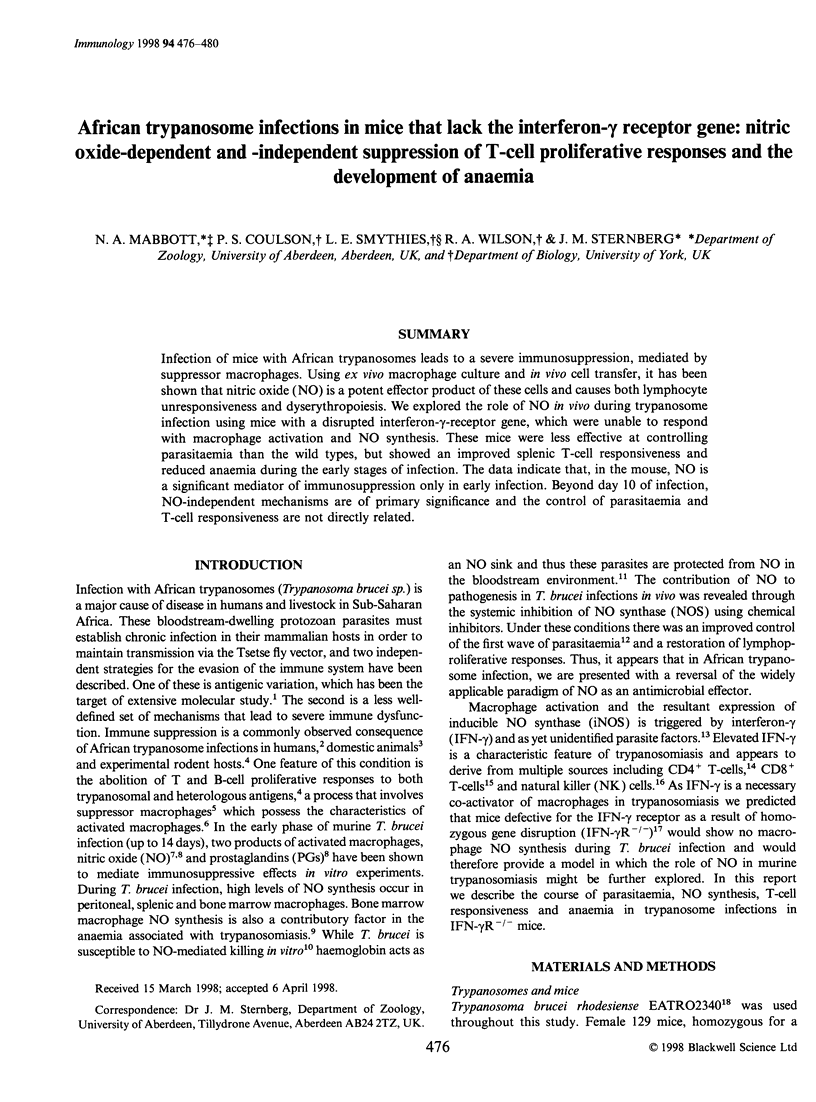
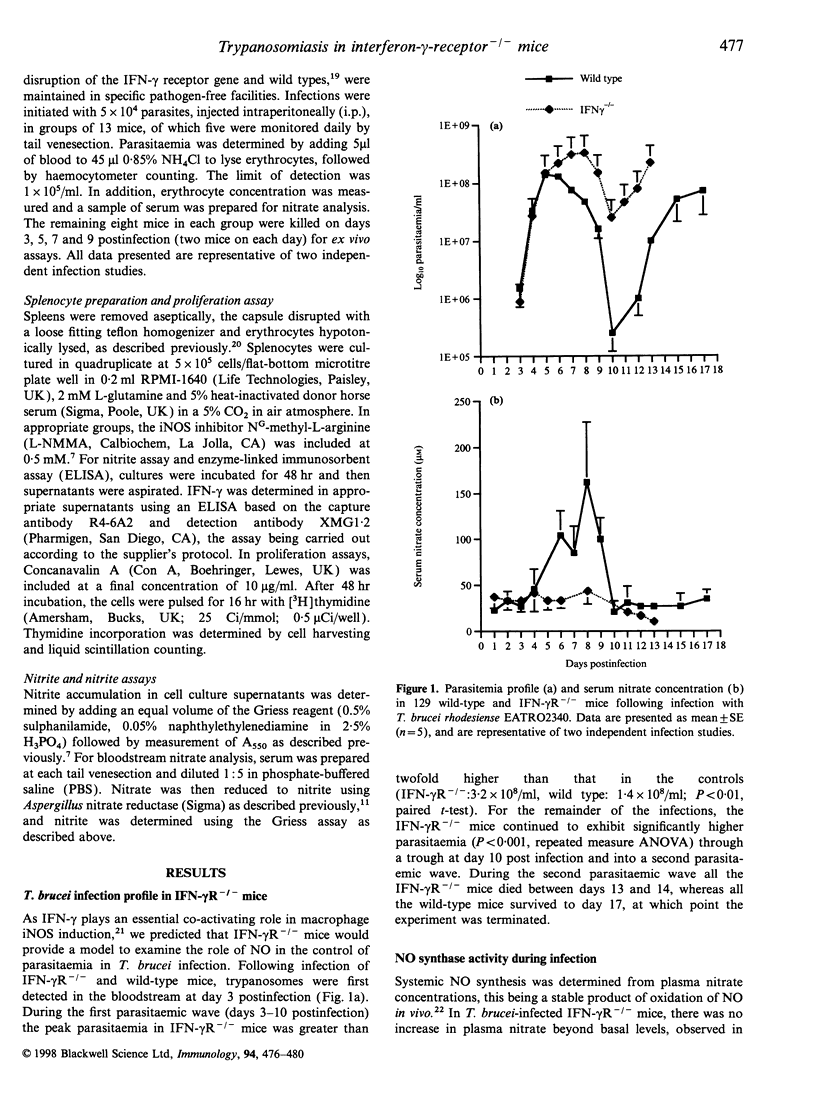
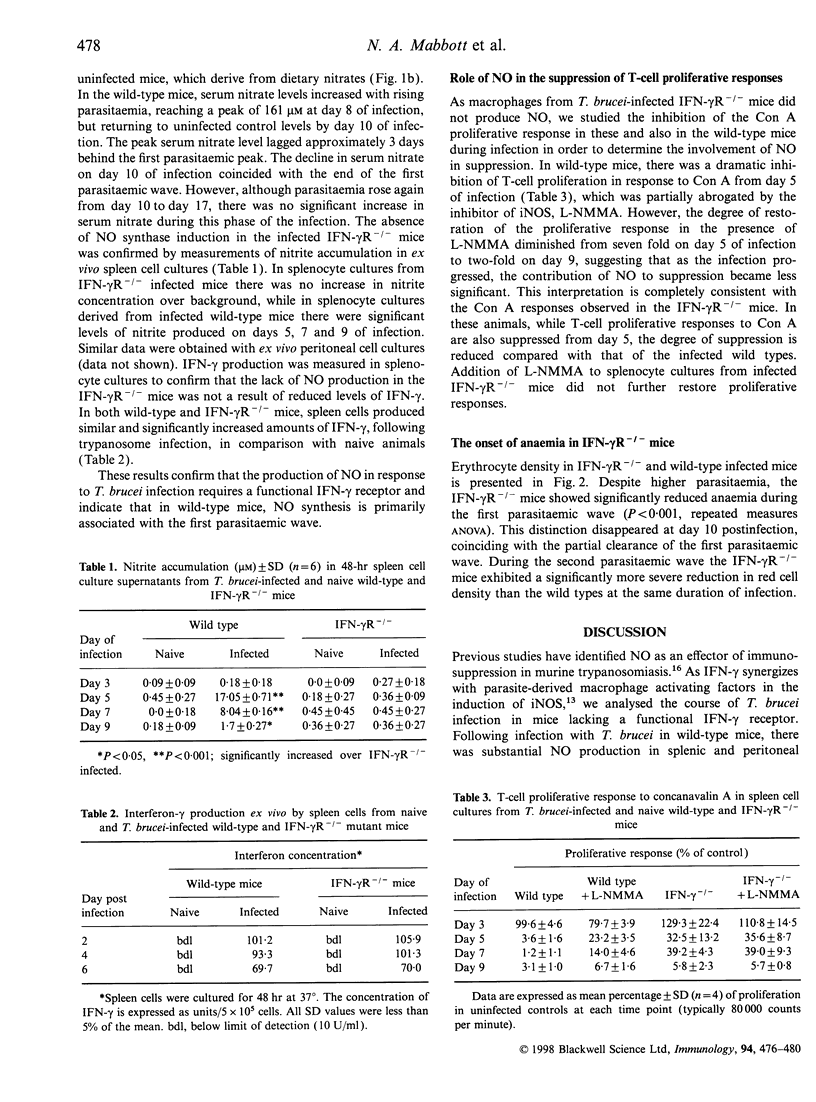
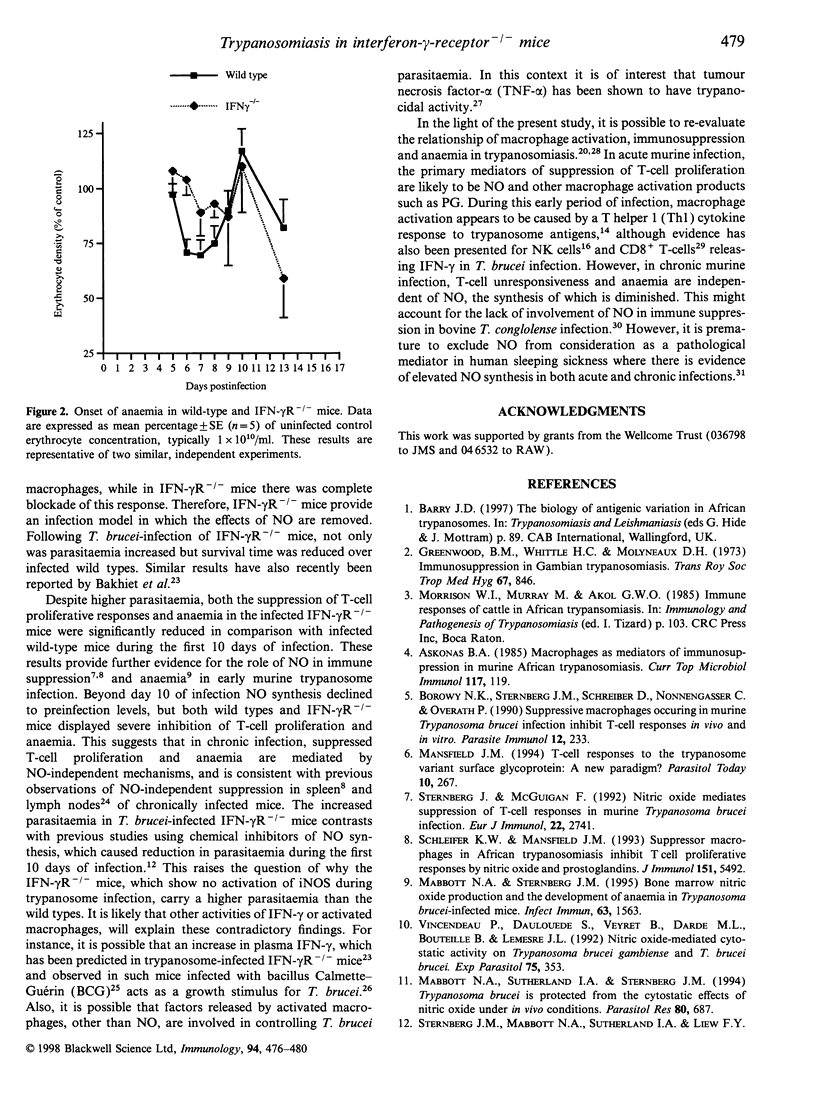
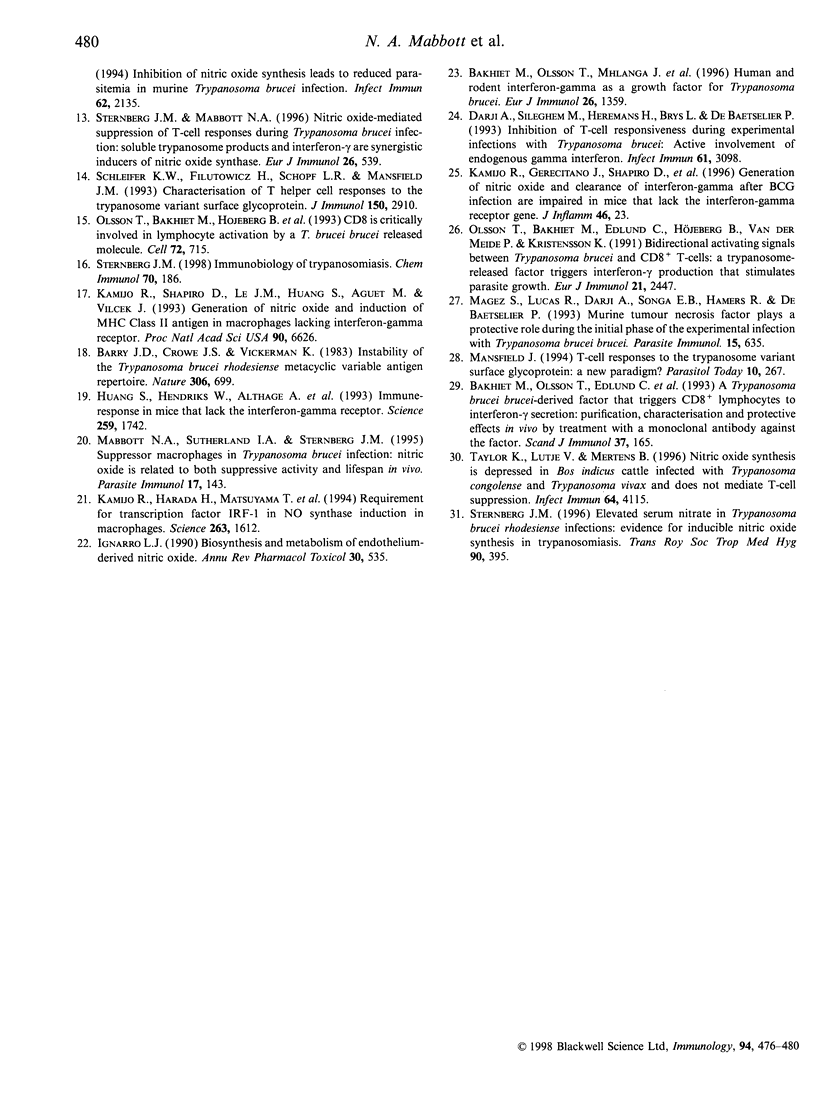
Selected References
These references are in PubMed. This may not be the complete list of references from this article.
- Askonas B. A. Macrophages as mediators of immunosuppression in murine African trypanosomiasis. Curr Top Microbiol Immunol. 1985;117:119–127. doi: 10.1007/978-3-642-70538-0_6. [DOI] [PubMed] [Google Scholar]
- Bakhiet M., Olsson T., Edlund C., Höjeberg B., Holmberg K., Lorentzen J., Kristensson K. A Trypanosoma brucei brucei-derived factor that triggers CD8+ lymphocytes to interferon-gamma secretion: purification, characterization and protective effects in vivo by treatment with a monoclonal antibody against the factor. Scand J Immunol. 1993 Feb;37(2):165–178. doi: 10.1111/j.1365-3083.1993.tb01753.x. [DOI] [PubMed] [Google Scholar]
- Bakhiet M., Olsson T., Mhlanga J., Büscher P., Lycke N., van der Meide P. H., Kristensson K. Human and rodent interferon-gamma as a growth factor for Trypanosoma brucei. Eur J Immunol. 1996 Jun;26(6):1359–1364. doi: 10.1002/eji.1830260627. [DOI] [PubMed] [Google Scholar]
- Barry J. D., Crowe J. S., Vickerman K. Instability of the Trypanosoma brucei rhodesiense metacyclic variable antigen repertoire. Nature. 1983 Dec 15;306(5944):699–701. doi: 10.1038/306699a0. [DOI] [PubMed] [Google Scholar]
- Borowy N. K., Sternberg J. M., Schreiber D., Nonnengasser C., Overath P. Suppressive macrophages occurring in murine Trypanosoma brucei infection inhibit T-cell responses in vivo and in vitro. Parasite Immunol. 1990 May;12(3):233–246. doi: 10.1111/j.1365-3024.1990.tb00951.x. [DOI] [PubMed] [Google Scholar]
- Darji A., Sileghem M., Heremans H., Brys L., De Baetselier P. Inhibition of T-cell responsiveness during experimental infections with Trypanosoma brucei: active involvement of endogenous gamma interferon. Infect Immun. 1993 Jul;61(7):3098–3102. doi: 10.1128/iai.61.7.3098-3102.1993. [DOI] [PMC free article] [PubMed] [Google Scholar]
- Greenwood B. M., Whittle H. C., Molyneux D. H. Immunosuppression in Gambian trypanosomiasis. Trans R Soc Trop Med Hyg. 1973;67(6):846–850. doi: 10.1016/0035-9203(73)90013-8. [DOI] [PubMed] [Google Scholar]
- Huang S., Hendriks W., Althage A., Hemmi S., Bluethmann H., Kamijo R., Vilcek J., Zinkernagel R. M., Aguet M. Immune response in mice that lack the interferon-gamma receptor. Science. 1993 Mar 19;259(5102):1742–1745. doi: 10.1126/science.8456301. [DOI] [PubMed] [Google Scholar]
- Ignarro L. J. Biosynthesis and metabolism of endothelium-derived nitric oxide. Annu Rev Pharmacol Toxicol. 1990;30:535–560. doi: 10.1146/annurev.pa.30.040190.002535. [DOI] [PubMed] [Google Scholar]
- Kamijo R., Gerecitano J., Shapiro D., Green S. J., Aguet M., Le J., Vilcek J. Generation of nitric oxide and clearance of interferon-gamma after BCG infection are impaired in mice that lack the interferon-gamma receptor. J Inflamm. 1995;46(1):23–31. [PubMed] [Google Scholar]
- Kamijo R., Harada H., Matsuyama T., Bosland M., Gerecitano J., Shapiro D., Le J., Koh S. I., Kimura T., Green S. J. Requirement for transcription factor IRF-1 in NO synthase induction in macrophages. Science. 1994 Mar 18;263(5153):1612–1615. doi: 10.1126/science.7510419. [DOI] [PubMed] [Google Scholar]
- Kamijo R., Shapiro D., Le J., Huang S., Aguet M., Vilcek J. Generation of nitric oxide and induction of major histocompatibility complex class II antigen in macrophages from mice lacking the interferon gamma receptor. Proc Natl Acad Sci U S A. 1993 Jul 15;90(14):6626–6630. doi: 10.1073/pnas.90.14.6626. [DOI] [PMC free article] [PubMed] [Google Scholar]
- Mabbott N. A., Sutherland I. A., Sternberg J. M. Suppressor macrophages in Trypanosoma brucei infection: nitric oxide is related to both suppressive activity and lifespan in vivo. Parasite Immunol. 1995 Mar;17(3):143–150. doi: 10.1111/j.1365-3024.1995.tb01016.x. [DOI] [PubMed] [Google Scholar]
- Mabbott N. A., Sutherland I. A., Sternberg J. M. Trypanosoma brucei is protected from the cytostatic effects of nitric oxide under in vivo conditions. Parasitol Res. 1994;80(8):687–690. doi: 10.1007/BF00932954. [DOI] [PubMed] [Google Scholar]
- Mabbott N., Sternberg J. Bone marrow nitric oxide production and development of anemia in Trypanosoma brucei-infected mice. Infect Immun. 1995 Apr;63(4):1563–1566. doi: 10.1128/iai.63.4.1563-1566.1995. [DOI] [PMC free article] [PubMed] [Google Scholar]
- Magez S., Lucas R., Darji A., Songa E. B., Hamers R., De Baetselier P. Murine tumour necrosis factor plays a protective role during the initial phase of the experimental infection with Trypanosoma brucei brucei. Parasite Immunol. 1993 Nov;15(11):635–641. doi: 10.1111/j.1365-3024.1993.tb00577.x. [DOI] [PubMed] [Google Scholar]
- Mansfield J. M. T-cell responses to the trypanosome variant surface glycoprotein: a new paradigm? Parasitol Today. 1994 Jul;10(7):267–270. doi: 10.1016/0169-4758(94)90143-0. [DOI] [PubMed] [Google Scholar]
- Mansfield J. M. T-cell responses to the trypanosome variant surface glycoprotein: a new paradigm? Parasitol Today. 1994 Jul;10(7):267–270. doi: 10.1016/0169-4758(94)90143-0. [DOI] [PubMed] [Google Scholar]
- Olsson T., Bakhiet M., Edlund C., Höjeberg B., Van der Meide P. H., Kristensson K. Bidirectional activating signals between Trypanosoma brucei and CD8+ T cells: a trypanosome-released factor triggers interferon-gamma production that stimulates parasite growth. Eur J Immunol. 1991 Oct;21(10):2447–2454. doi: 10.1002/eji.1830211022. [DOI] [PubMed] [Google Scholar]
- Olsson T., Bakhiet M., Höjeberg B., Ljungdahl A., Edlund C., Andersson G., Ekre H. P., Fung-Leung W. P., Mak T., Wigzell H. CD8 is critically involved in lymphocyte activation by a T. brucei brucei-released molecule. Cell. 1993 Mar 12;72(5):715–727. doi: 10.1016/0092-8674(93)90400-k. [DOI] [PubMed] [Google Scholar]
- Schleifer K. W., Filutowicz H., Schopf L. R., Mansfield J. M. Characterization of T helper cell responses to the trypanosome variant surface glycoprotein. J Immunol. 1993 Apr 1;150(7):2910–2919. [PubMed] [Google Scholar]
- Schleifer K. W., Mansfield J. M. Suppressor macrophages in African trypanosomiasis inhibit T cell proliferative responses by nitric oxide and prostaglandins. J Immunol. 1993 Nov 15;151(10):5492–5503. [PubMed] [Google Scholar]
- Sternberg J. M. Elevated serum nitrate in Trypanosoma brucei 'rhodesiense' infections: evidence for inducible nitric oxide synthesis in trypanosomiasis. Trans R Soc Trop Med Hyg. 1996 Jul-Aug;90(4):395–395. doi: 10.1016/s0035-9203(96)90519-2. [DOI] [PubMed] [Google Scholar]
- Sternberg J. M. Immunobiology of African trypanosomiasis. Chem Immunol. 1998;70:186–199. doi: 10.1159/000058706. [DOI] [PubMed] [Google Scholar]
- Sternberg J., McGuigan F. Nitric oxide mediates suppression of T cell responses in murine Trypanosoma brucei infection. Eur J Immunol. 1992 Oct;22(10):2741–2744. doi: 10.1002/eji.1830221041. [DOI] [PubMed] [Google Scholar]
- Sternberg M. J., Mabbott N. A. Nitric oxide-mediated suppression of T cell responses during Trypanosoma brucei infection: soluble trypanosome products and interferon-gamma are synergistic inducers of nitric oxide synthase. Eur J Immunol. 1996 Mar;26(3):539–543. doi: 10.1002/eji.1830260306. [DOI] [PubMed] [Google Scholar]
- Taylor K., Lutje V., Mertens B. Nitric oxide synthesis is depressed in Bos indicus cattle infected with Trypanosoma congolense and Trypanosoma vivax and does not mediate T-cell suppression. Infect Immun. 1996 Oct;64(10):4115–4122. doi: 10.1128/iai.64.10.4115-4122.1996. [DOI] [PMC free article] [PubMed] [Google Scholar]
- Vincendeau P., Daulouède S., Veyret B., Darde M. L., Bouteille B., Lemesre J. L. Nitric oxide-mediated cytostatic activity on Trypanosoma brucei gambiense and Trypanosoma brucei brucei. Exp Parasitol. 1992 Nov;75(3):353–360. doi: 10.1016/0014-4894(92)90220-5. [DOI] [PubMed] [Google Scholar]


